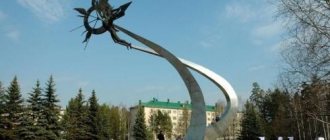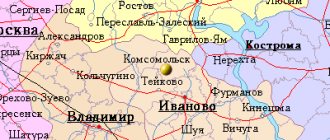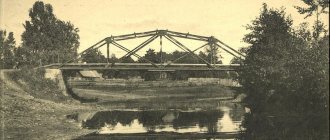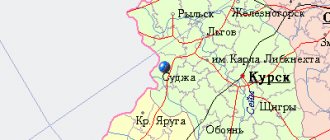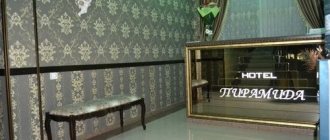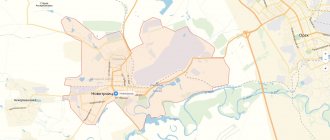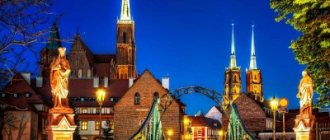This toponym has other meanings, see Ipatovo.
| City | |
| Ipatovo | |
| Flag | Coat of arms |
until 1935 —
WinemakingCity since 1979 Area 16 [1] km² Center height 100 m Climate type temperate Time zone UTC+3:00 Population Population↘22,816 [2] people (2021) Density 1,426 people/km² Katoykonimipatovtsy, Ipatovets, Ipatovka Digital identifiers Telephone code +7 8654 2 Postal code 356630 OKATO code 07222501000 OKTMO code 07622101001 Other Map sheet nomenclature L-38-74ipatovo.org Ipatovo
Moscow
Stavropol
Ipatovo
Media files on Wikimedia CommonsIpatovo
- city[3] in the Stavropol Territory. The administrative center of the Ipatovsky urban district and the Ipatovsky district.
Geography
Ipatovo is the northernmost city of Stavropol, located on the left bank of the Kalaus River, 135 km northeast of Stavropol.
The federal highway P216 (until the end of 2022 it is allowed to use the old designation A154) Astrakhan - Stavropol runs near the city.
The height above sea level is 100 meters.
The Chemrek stream, flowing along the Terengoy gully, crosses the city from west to east and flows into the Kalaus River[4].
Climate
The hydrothermal climate is characterized as arid. Temperatures in summer reach +45, in winter -35 degrees.
Winds from the east and west directions predominate. Eastern winds coming from the Aral-Caspian desert are dry and hot in summer and cold in winter. Sometimes they blow for a long time, removing the arable layer, forming dust storms. This dry wind is popularly called “Astrakhan”, “Astrakhan rain”. The speed of eastern winds is on average 21 m/sec., Western winds are 24 m/sec[4].
Ipatovo
(Stavropol region)
OKATO code:
07222501
Founded:
1860
City since:
1979 City of regional subordination
Center:
Ipatovsky district
The city was formerly called:
| Winemaking | 1935 |
| Telephone code (reference phone) | |
| 86542***** | 22-2-22 |
Deviation from Moscow time, hours:
0
Geographic latitude:
45°43′
Geographic longitude:
42°54′
Altitude above sea level, meters:
100 Sunrise and sunset times in the city of Ipatovo
Story
The settlement was formed in 1860, on government land, and was named Chemrek
(presumably connected with the name of the Nogai prince, buried near the village).
The first settlers came from Voronezh, Poltava and Kharkov provinces[5]. In the decree of Emperor Alexander II of March 13, 1860, it is listed as a village
of the Stavropol district of the Stavropol province, in archival documents for 1861 - as
a village
[6]:543:
The Chamber of State Property in pursuance of the Highest command set out in the proposal of the Stavropol Civil Governor dated July 29 [1861] No. 4295, located on the Kalmyk steppe of the Stavropol Province, the villages of Divnaya, Vinodelnaya, Predtecha, Derbetovka, named [nrzb] villages...
— From [7]
The population grew all the time due to influx from outside. In 1864, 144 families of Nogais who returned from Turkey settled in the village.
In 1871, the Vinodelenskaya volost
[6]:543.
In 1880, the village was renamed Vinodelnoye
. The name is associated with large state-owned wine warehouses where wine was bottled.
According to data for 1896, in the village there were 980 households with 1000 houses, in them there were 1460 revision souls according to salary sheets, according to family lists - 2755 male souls and 2396 female souls, 503 people from other cities. There were 4 manufacturing shops, 5 groceries, 1 wine warehouse, 2 taverns, 5 dukhans, 1 inn, 34 windmills, 8 sheep factories, 3 oil mills. There were two schools: a one-class school for the Ministry of Public Education and a parish school. Medical assistance to residents was provided by a paramedic[4].
On August 24, 1920, construction of the railway was completed, and on September 4, the first train arrived in the village of Vinodelnoye[4].
In 1925, the village of Vinodelnoye was part of the Vinodelnoye Village Council[4].
At the beginning of the 30s, in the village of Vinodelny there was a brick and tile factory, a creamery and a mill, a regional industrial trust, an oil depot, a veterinary laboratory, a small power plant called “Smychka”, and the Vinodelnaya railway station[4].
Until August 1930, the collective farm “1st Cavalry Army” operated in the village. In August, about half of its collective farmers were resettled to the Krasnodar region (to the place of the repressed Cossacks). An agricultural artel named after Vinodelny was organized. Budyonny, fuck it. Vodnoye - collective farm "New Life". In 1931, the agricultural artel was renamed the collective farm named after. Sheiko, all farms located on the territory of Winemaking, Vodnoye, Kocherzhinsky and Bondarevsky joined him. In 1932, this enterprise was disaggregated into eight collective farms: named after Budyonny, named after Kalinin, named after Stalin, named after Golubovsky, named after Sheiko, “17 Years of October”, “New Life”, “Red Army Man”[4].
In 1935, the village was renamed Ipatovo in honor of the Civil War participant Pyotr Maksimovich Ipatov, who died here in 1918[8].
In the mid-thirties, the buildings of the House of Culture, library, cinema "October" and an elementary school were built[4].
| External images |
On December 3, 1979, the settlement received city status[9], becoming the 1001st city in Russia[10].
Until May 1, 2022, the city was the administrative center of the abolished urban settlement of Ipatovo[11][12].
Composition of the settlement
| № | Locality | Type of settlement | Population |
| 1 | Bondarevsky | farm | ↘400[19] |
| 2 | Water | farm | ↘100[19] |
| 3 | Ipatovo | city, administrative center | ↘22 816[20] |
| 4 | Kocherzhinsky | farm | ↗300[19] |
On July 7, 1964, the Sidorenko farm was excluded from the list of settlements as it had merged with the village of Ipatovo[5].
Population
| Population | |||||||||
| 1881[4] | 1897[13] | 1903[14] | 1908[15] | 1925[16] | 1926[17] | 1939[18] | 1959[19] | 1970[20] | 1979[21] |
| 1447 | ↗7200 | ↗8770 | ↘8281 | ↘7833 | ↗9877 | ↗12 383 | ↗13 670 | ↗18 527 | ↗22 024 |
| 1989[22] | 1992[23] | 1996[23] | 1998[23] | 2000[23] | 2001[23] | 2002[24] | 2003[23] | 2005[23] | 2006[23] |
| ↗26 425 | ↗27 200 | ↗28 600 | ↗28 800 | ↘28 700 | ↘28 600 | ↘28 594 | ↗28 600 | ↘28 100 | ↘28 000 |
| 2007[23] | 2008[25] | 2009[26] | 2010[27] | 2011[28] | 2012[29] | 2013[30] | 2014[31] | 2015[32] | 2016[33] |
| ↘27 900 | ↗28 100 | ↗28 117 | ↘26 053 | ↘26 046 | ↘25 794 | ↘25 468 | ↘25 155 | ↘24 966 | ↘24 782 |
| 2017[34] | 2018[35] | 2019[36] | 2020[37] | 2021[2] | |||||
| ↘24 390 | ↘24 021 | ↘23 579 | ↘23 214 | ↘22 816 | |||||
As of January 1, 2022, in terms of population, the city was in 605th place out of 1,116[38]cities of the Russian Federation[39].
Gender composition
According to the results of the 2010 population census, there were 12,184 men (45.32%) and 14,699 women (54.68%)[27].
National composition
According to the results of the 2010 population census, the following nationalities lived (nationalities less than 1%, see footnote to the line “Others”)[27]:
| Nationality | Number | Percent |
| Russians | 25 675 | 95,51 |
| Others[40] | 1208 | 4,49 |
| Total | 26 883 | 100,00 |
Infrastructure
- Employment center
- Center for Social Services
- Social rehabilitation center for minors "Prichal"
- Civil Registration Department
- Department of Property and Land Relations
- Department of Architecture and Urban Planning
- Center for methodological, accounting and economic and technical support
- Ipatovo railway station
- Bus station in Ipatovo
- Forestry
- Regional station for combating animal diseases
- 3 public cemeteries: old (closed), with an area of 52,700 m², and 2 new (open), with an area of 91,792 m² and 53,117 m²[41].
Education
- Kindergarten No. 1 “Firefly”
- Kindergarten No. 2 “Ogonyok”
- Kindergarten No. 3 “Swallow”
- Kindergarten No. 4 “Beryozka”
- Kindergarten No. 5 “Rucheyok”
- Kindergarten No. 6 “Fairy Tale”
- Kindergarten No. 7 “Thumbelina”
- Kindergarten No. 18 “Fidget”
- Kindergarten No. 28 “Rainbow”
- Secondary school No. 1
- Secondary school No. 6
- Secondary school No. 14
- Secondary school No. 22
- Children's art school
- Children's art school
- Children's and youth sports school
- Center for additional education for children. Opened May 7, 2010[43]
Economy
- Feed mill[44].
- Auto repair plant[44].
- JSC "Syrodel" Opened on October 18, 1930 as a creamery[45]
- Elevator. Opened October 11, 1925[45]
- Brick factory with a capacity of 60 million bricks per year. Construction began in February 2015[46]
- Brewery
- Combine of industrial enterprises "Ipatovsky". Opened on January 1, 1963 as the Rural Construction Plant[47]
- Road repair and construction department. Established on June 16, 1991 as road maintenance site No. 641[48]
- Agro-industrial complex "South-Agroprogress". Opened February 5, 2005[43]
- Grains and melons are grown in the area. Sheep breeding (Caucasian and Stavropol breeds). Cattle are raised
- Deposits of natural gas, stone, crushed stone, sand, clay, mineral water
Sport
- Progress Stadium. Opened on May 9, 1975 as Runo Stadium[43]
- Motordrome "Kolos"
- Motorcycle club "Kolos". Champion of Russia 2022. Five-time silver medalist of the Russian championships (2013, 2014, 2015, 2016, 2017). Two-time bronze medalist of the Russian championships (1992, 2011). Winner of the Russian Cup 2022[49]. Russian Cup finalist - 5 (2011, 2013, 2015, 2022, 2018). In the USSR championships, the best result was 8th place (1990). In USSR cups, the best result is 2nd place in the group (1990). Winner of the USSR championship (first league) - 1989. Winner of the USSR championship (second league) - 1986. Second place in the RSFSR championship - 1980[50].
mass media
Printed publications
- Newspaper "Steppe Dawns"
Radio stations
- "Radio Russia" / "GTRK Stavropol" 66.86 FM
- "Radio Mayak" 68.30 FM
- Radio 7 on Seven Hills 102.0 FM
- "New Radio" 102.4 FM
- "Road Radio" 104.8 FM
- "Radio Chanson" 105.3 FM
Television
Broadcasting point Digital terrestrial television
[51]
Federal channels
|
|
|
|
Russian Orthodox Church
According to available archival documents[4], in 1864, in the village, at the expense of parishioners, a prayer house made of mud brick, covered with straw, was built. Its bells were placed on stone pillars.
In 1868, the construction of a new wooden Church of the Nativity of the Blessed Virgin Mary began and was completed in 1870 on a stone foundation with the same bell tower and linen iconostasis. The church was consecrated in 1870. In 1914, through the diligence of parishioners, a new building was built for the church; it was consecrated on December 13.
The Ascension Three-Altar Church was built in 1903 at the expense of parishioners. It had a brick building.
In the Winery there was the Kazan Agafodorov convent; the women's community was established by the Archbishop of Stavropol and Ekaterinodar Agafodorov in 1909 in memory of his parents - reader Flegont and Evdokia. By 1913, the community had a church in honor of the Kazan Icon of the Mother of God, a hospice house, 42 cells for nuns, a refectory, a psalter, and a prosphora. 80 sisters lived in the community, they ran the household independently, and the sisters were supported by local funds. In 1913, the community was transformed into a female monastery.
On the site of a closed monastic community (now the territory of a repair plant), in 1921 the first school-commune in the region was organized - named after the Third International.
Excerpt characterizing Ipatovo
In relation to trade and for food for the army, the following was posted everywhere: Proclamation “You, calm Moscow residents, artisans and working people, whom misfortunes have removed from the city, and you, scattered farmers, whom unfounded fear still detains in the fields, listen! Silence returns to this capital, and order is restored in it. Your fellow countrymen come out boldly from their shelters, seeing that they are respected. Any violence committed against them and their property is immediately punished. His Majesty the Emperor and King protects them and among you does not consider anyone to be his enemies, except those who disobey his commands. He wants to end your misfortunes and return you to your courts and your families. Comply with his charitable intentions and come to us without any danger. Residents! Return with confidence to your homes: you will soon find ways to satisfy your needs! Craftsmen and hardworking craftsmen! Come back to your handicrafts: houses, shops, security guards are waiting for you, and for your work you will receive the payment due to you! And you, peasants, finally come out of the forests where you hid in horror, return without fear to your huts, in the exact assurance that you will find protection. Storehouses have been established in the city, where peasants can bring their excess supplies and land plants. The government took the following measures to ensure free sale for them: 1) Starting from this date, peasants, farmers and those living in the vicinity of Moscow can, without any danger, bring their supplies to the city, of whatever kind, in two designated storage areas, that is, at Mokhovaya and Okhotny Ryad. 2) These foodstuffs will be purchased from them at such a price as the buyer and seller agree upon; but if the seller does not receive the fair price he demands, then he will be free to take them back to his village, which no one can prevent him from doing under any circumstances. 3) Every Sunday and Wednesday are designated weekly for major trading days; why a sufficient number of troops will be stationed on Tuesdays and Saturdays on all major roads, at such a distance from the city, to protect those carts. 4) The same measures will be taken so that there are no obstacles on the way back to the peasants with their carts and horses. 5) The funds will be immediately used to restore normal trading. Residents of the city and villages, and you, workers and artisans, no matter what nation you are! You are called upon to fulfill the paternal intentions of His Majesty the Emperor and the King and to contribute with him to the general welfare. Bring respect and trust to his feet and do not hesitate to unite with us!” In order to raise the morale of the troops and the people, reviews were constantly held and awards were given out. The emperor rode horseback through the streets and consoled the residents; and, despite all his preoccupation with state affairs, he himself visited the theaters established on his orders. In terms of charity, the best valor of the crowned people, Napoleon also did everything that depended on him. On charitable institutions he ordered the inscription Maison de ma mere [My Mother's House], uniting by this act the tender filial feeling with the greatness of the virtue of the monarch. He visited the Orphanage and, letting the orphans he saved kiss his white hands, graciously talked with Tutolmin. Then, according to Thiers’ eloquent account, he ordered that the salaries of his troops be distributed in Russian, made by him, with counterfeit money. Relevant l'emploi de ces moyens par un acte digue de lui et de l'armee Francaise, il fit distribuer des secours aux incendies. Mais les vivres etant trop precieux pour etre donnes a des etrangers la plupart ennemis, Napoleon aima mieux leur fournir de l'argent afin qu'ils se fournissent au dehors, et il leur fit distribuer des roubles papiers. [Elevating the use of these measures to an action worthy of him and the French army, he ordered the distribution of benefits to the burnt. But, since food supplies were too expensive to give to people of a foreign land and for the most part hostile, Napoleon considered it best to give them money so that they could obtain food for themselves on the side; and he ordered that they be provided with paper rubles.] With regard to the discipline of the army, orders were constantly issued for strict penalties for failure to fulfill the duty of service and for the cessation of robbery. X But it’s a strange thing, all these orders, concerns and plans, which were no worse than others issued in similar cases, did not affect the essence of the matter, but, like the hands of a dial in a watch, separated from the mechanism, spun arbitrarily and aimlessly, without affecting the wheels . Militarily, the ingenious campaign plan that Thiers talks about; que son genie n'avait jamais rien imagine de plus profond, de plus habile et de plus admirable [his genius never invented anything deeper, more skillful and more amazing] and regarding which Thiers, entering into polemics with Mr. Fehn, proves that the drawing up of this brilliant plan should be dated not to the 4th, but to the 15th of October, this plan never was and could not be executed, because it had nothing close to reality. The strengthening of the Kremlin, for which it was necessary to tear down la Mosquee [mosque] (as Napoleon called St. Basil's Church), turned out to be completely useless. Laying mines under the Kremlin only contributed to the fulfillment of the emperor’s desire, upon leaving Moscow, for the Kremlin to be blown up, that is, for the floor on which the child was killed to be beaten. The persecution of the Russian army, which so concerned Napoleon, presented an unheard-of phenomenon. The French military leaders lost the sixty-thousandth Russian army, and only, according to Thiers, the art and, it seems, also the genius of Murat managed to find, like a pin, this sixty-thousandth Russian army. Diplomatically, all of Napoleon’s arguments about his generosity and justice, both before Tutolmin and before Yakovlev, who was primarily concerned with acquiring an overcoat and a cart, turned out to be useless: Alexander did not accept these ambassadors and did not respond to their embassy. From a legal point of view, after the execution of the alleged arsonists, the other half of Moscow burned down. Administratively, the establishment of the municipality did not stop the robbery and only brought benefit to some individuals who participated in this municipality and, under the pretext of maintaining order, robbed Moscow or saved theirs from robbery. In terms of religion, things that were so easily arranged in Egypt by visiting a mosque did not bring any results here. Two or three priests found in Moscow tried to carry out the will of Napoleon, but one of them was beaten on the cheeks by a French soldier during the service, and the French official reported the following about the other: “Le pretre, que j'avais decouvert et invite a recommencer a dire la messe, a nettoye et ferme l'eglise. Cette nuit on est venu de nouveau enfoncer les portes, casser les cadenas, dechirer les livres et commettre d'autres desordres.” [“The priest, whom I found and invited to begin saying mass, cleaned out and locked the church. That same night they came again to break doors and locks, tear up books and cause other disturbances.”] In terms of trade, there was no response to the proclamation to the hardworking artisans and all peasants. There were no hardworking artisans, and the peasants caught those commissars who went too far with this proclamation and killed them. With regard to entertaining the people and troops with theatres, things were similarly unsuccessful. The theaters established in the Kremlin and in Poznyakov’s house immediately closed because actresses and actors were robbed. Charity did not bring the desired results either. False banknotes and fake ones filled Moscow and had no price. For the French, who collected booty, all they needed was gold. Not only were the false banknotes that Napoleon so graciously distributed to the unfortunate had no price, but silver was given below its value for gold. But the most striking phenomenon of the invalidity of the highest orders at that time was Napoleon's efforts to stop the robberies and restore discipline. This is what the army officials reported. “Robberies continue in the city, despite orders to stop them. Order has not yet been restored, and there is not a single merchant conducting trade in a legal manner. Only sutlers allow themselves to sell, and only looted things.” “La partie de mon arrondissement continue a etre en proie au pillage des soldats du 3 corps, qui, non contents d'arracher aux malheureux refugies dans des souterrains le peu qui leur reste, ont meme la ferocite de les blesser a coups de sabre, comme j'en ai vu plusieurs exemples." “Rien de nouveau outre que les soldats se permettent de voler et de piller. Le 9 October.” “Le vol et le pillage continuent.” Il ya une bande de voleurs dans notre district qu'il faudra faire arreter par de fortes gardes. Le 11 October.” [“Part of my district continues to be plundered by the soldiers of the 3rd Corps, who are not content with taking away the meager property of the unfortunate inhabitants who hid in the basements, but also cruelly inflict wounds on them with sabers, as I myself have seen many times.” “Nothing new, just that soldiers allow themselves to rob and steal. October 9." “Theft and robbery continue. There is a gang of thieves in our area that will need to be stopped with strong measures. October 11.”] “The Emperor is extremely dissatisfied that, despite strict orders to stop the robbery, only detachments of Guards marauders are visible returning to the Kremlin. In the old guard, riots and looting resumed more than ever yesterday, last night and today. The emperor sees with condolences that the selected soldiers appointed to guard his person, who should set an example of subordination, are disobedient to such an extent that they destroy the cellars and stores prepared for the army. Others humiliated themselves to the point of not listening to the sentries and guard officers, cursing them and beating them.”
Honorary citizens of the city of Ipatovo
List of honorary citizens[4]:
- A. G. Babkin
- Nikolai Timofeevich Vilgotsky
- Viktor Alekseevich Gatilo
- I. Z. Glushko
- Gorbatko Viktor Vasilievich (1934 - 2017) - Soviet cosmonaut.
- Gorbachev Igor Olegovich (1927 - 2003) - Soviet and Russian theater and film actor.
- Andrey Grigorievich Zadorozhny
- Ipatov Pyotr Maksimovich (1887 - 1918) - Russian revolutionary, Bolshevik.
- Kalyagin Viktor Vladimirovich (1932 - 2021) - Soviet economic, statesman and political figure, Hero of Socialist Labor. Honorary citizen of Ipatovo
- Tatyana Nikolaevna Kolbasina
- Pavel Vasilievich Kolesnikov
- A. A. Ostrolutsky
- V. I. Sklyarov - chairman of the collective farm named after. Kirov from 1970 to 1988.
- Georgy Georgievich Starshikov
- Vasily Pavlovich Shestak
Management
The city was led[4]:
Chairmen of the Village Council
- 1938-1940 — A. Topchev
- from 02/03/1943 - Katygrob Akim Mikhailovich
- from 03/06/1943 - Omelnichuk
- from 05/17/1944 - Bely
- from 12/04/1944 - Lapiko
- from 01/17/1946 - M.A. Klochko
- from 05/31/1946 - A.I. Sokolov
- 10.21.1946 - 05.31.1948 - Parkhomenko Fedor Grigorievich
- 07/02/1948 - 09/23/1948 - Manuylo Ivan Nikiforovich
- 09/23/1948 - 10/22/1954 - Semkin Stefan Zinovievich
- 10.22.1954 - 03.07.1957 - Avramenko Alexander Mikhailovich
- 03/07/1957 - 10/31/1958 - Kaliturin Alexander Ivanovich
- 10.31.1958 - 03.10.1959 - Baranov Andrey Semenovich
- 03/10/1959 - 03/19/1965 - Perepilitsyn Vladimir Ilyich
- 03/19/1965 - 10/25/1972 - Alexey Nikonorovich Timchenko
- 10/25/1972 - 1975 - Fitisov Vladimir Maksimovich
- 1975 -1979 — Gatilo Viktor Alekseevich
Chairmen of the City Executive Committee
- 03.12.1979 - 12.1989 - Gatilo Viktor Alekseevich
- 12.1989 - 12.1991 - Zotov Vasily Kirillovich
Heads of Administration
- 12.1991 - 02.1993 - Zotov Vasily Kirillovich
- 03.1993 - 03.1997 - Olga Igorevna Khistnaya
- 01.1997 - 12.2000 - Popov Mikhail Pavlovich
- 12.2000 - 01.2002 - Sidorenko Valery Fedorovich
- 05.2002 - 12.2005 - Skorik Natalya Yakovlevna
- 01.2006 - 04.2011 - Olga Igorevna Khistnaya
- from May 5, 2011 Ivan Vasilievich Litvinov
Heads of the urban settlement
- from December 4, 2005 to the present Valery Borisovich Galaktionov
Monuments
Archaeological sites
In the vicinity of the city, on the right bank of the Kalaus, there is a barkhanchak 2 burial mound. During its excavations, a number of burials were identified dating back to the Early, Late and Middle Bronze Ages, as well as the Early Iron Age and the Middle Ages. The grave goods included pottery, bone pins, stone anvils and other objects. The monument is of scientific, historical and cultural value and is part of the historical and cultural heritage of the Stavropol Territory[52].
Monuments of history and art
- Obelisk at the site of the execution of 86 civilians[53];
- Mass grave of 16 Soviet soldiers[54];
- Monument to V.I. Lenin. 1952[55];
- Monument to K. Marx. 1952[56];
- Monument to the hero of the civil war P. M. Ipatov. 1957[57];
- Memorial to soldiers of the Civil and Great Patriotic War[58]
- Walk of Fame[59]
People associated with the city
- Bondarenko, Oleg Vyacheslavovich (1966, Ipatovo - 2001) - participant in two Chechen wars, Hero of the Russian Federation
- Bugaisky, Viktor Nikiforovich (1912, Vinodelnoye - 1994) - chief designer of the Kaliningrad Machine-Building Plant (Buran spacecraft)
- Vorotnikov, Semyon Pavlovich (1896, Winery - ?) - Hero of Socialist Labor.
- Logvin, Andrey Nikolaevich (1964, Ipatovo) - Russian poster artist, graphic artist, designer in the field of graphic design and advertising. Laureate of the State Prize of the Russian Federation in the field of literature and art. Author of the poster “Life is Good” in the collection of the Tretyakov Gallery
- Spodin, Ivan Evdokimovich (1926) - participant in the Great Patriotic War of 1941-1945, holder of the Order of the Patriotic War, 1st degree, Red Star, Red Banner of Labor[28]
Notes
- Territory, population density in the Stavropol Territory as of 01/01/2012 (unspecified)
(inaccessible link -
history
). - ↑ 12
The permanent population of the Russian Federation by municipalities as of January 1, 2022 (Russian). Retrieved April 27, 2022. Archived May 2, 2022. - ↑ 1 2
Register of geographical names of objects registered in the AGKGN as of 11/18/2011.
Stavropol Territory (undefined)
. Access date: July 18, 2022. Archived May 12, 2017. - ↑ 1234567891011
The steppe cradle of heroes. History of the Ipatovsky municipal district of the Stavropol Territory. Author-compiler V.N. Krotenko - Stavropol, 2014. p. 396 - Tvalchrelidze, 1991, p. 283-284.
- ↑ 12
Administrative-territorial structure of Stavropol from the end of the 18th century to 1920: [arch. October 23, 2018] / G. A. Nikitenko (responsible compiler), E. B. Gromova, M. I. Krivneva; Committee of the Stavropol Territory for Archives, State Archives of the Stavropol Territory. - Stavropol, 2008. - 705 p. - Calendar of anniversaries, significant and memorable dates of the Stavropol Territory for 2016. 155 years of the village of Kazgulak, Turkmen region (unspecified)
.
Website of the State Archive of the Stavropol Territory
. Archived from the original on May 8, 2022. - Shapovalov, 2006, p. 143.
- Decree of the Presidium of the Supreme Council of the RSFSR of December 3, 1979 “On the transformation of the village of Ipatovo, Ipatovo district, Stavropol Territory into a city of regional subordination” // Gazette of the Supreme Council of the RSFSR. - 1979. - No. 50 (December 13). — P. 1012.
- Nadezhda Babenko.
Ipatovo is the 1001st city in Russia
(unspecified)
.
Stavropolskaya Pravda
(October 30, 2010). Access date: August 28, 2016. Archived June 16, 2013. - Law of the Stavropol Territory of October 4, 2004 No. 88-kz “On granting municipalities of the Stavropol Territory the status of an urban, rural settlement, urban district, municipal district” (undefined)
. Access date: September 25, 2012. Archived December 5, 2012. - Law of the Stavropol Territory of April 29, 2016 No. 48-kz “On the transformation of municipalities that are part of the Ipatovsky municipal district of the Stavropol Territory, and on the organization of local self-government in the territory of the Ipatovsky municipal district of the Stavropol Territory” (unspecified)
.
Official Internet portal of legal information of the Stavropol Territory
. Archived from the original on July 18, 2022. - Populated areas of the Russian Empire with 500 or more inhabitants, indicating the total population present in them and the number of inhabitants of the prevailing religions, according to the first general census of 1897: [arch. August 17, 2013] / preface: N. Troinitsky. — St. Petersburg: Printing house “Public Benefit”. Steam tipo-lit. N. L. Nyrkina, 1905. - X, 270, 120 p. — (The first general census of the Russian Empire in 1897 / edited by N. A. Troinitsky).
- Memorial book of the Stavropol province for 1904 / comp. L. N. Kulisich; Stavropol Provincial Statistical Committee. — Stavropol: Hereditary Printing House. Burke "North Caucasus", 1904. - 237 p.
- Mikhailov N. T.
Handbook of the Stavropol diocese / comp. priest N. T. Mikhailov. - Ekaterinodar: Printing house of the Kuban regional government, 1910. - 2, IV, 3-501 p. - (Stavropol province and Kuban region (overview of cities, villages, villages and farmsteads). - For the region, date: 1911. - List of populated places in the North Caucasus Territory / North Caucasus Regional Statistical Office. - Rostov-on-Don, 1925. - XII, 649 p. — (Materials on statistics of the North Caucasus region).
- Settled results of the 1926 census in the North Caucasus region / North Caucasus Regional Statistical Office. Census department. - Rostov-on-Don, 1929. - II, 468, 83 p.
- Population of the USSR as of January 17, 1939: by region, regional centers, cities, workers' settlements and large rural settlements. - M.: Gosplanizdat, 1941. - 266 p.
- All-Union Population Census of 1959. The size of the rural population of the RSFSR - residents of rural settlements - district centers by gender (unspecified)
.
Demoscope Weekly
. Access date: January 2, 2014. Archived November 7, 2017. - All-Union population census of 1970. The size of the rural population of the RSFSR - residents of rural settlements - regional centers by gender (unspecified)
.
Demoscope Weekly
. Retrieved October 14, 2013. Archived October 14, 2013. - All-Union Population Census of 1979. The size of the rural population of the RSFSR - residents of rural settlements - district centers (undefined)
.
Demoscope Weekly
. Access date: December 29, 2013. Archived December 29, 2013.} - All-Union population census of 1989. Urban population (undefined)
.
Demoscope Weekly
. Archived from the original on August 22, 2011. - ↑ 1 2 3 4 5 6 7 8 9
Ipatovo
(unspecified)
.
People's encyclopedia "My City"
. Retrieved October 12, 2013. Archived October 12, 2013. - Population size for each urban and rural settlement of the Stavropol Territory as of the date of VPN-1989 and VPN-2002 (undefined)
.
stavrop.gks.ru
. Retrieved January 12, 2015. Archived January 12, 2015. - Cities of the Stavropol Territory (number of inhabitants - estimate as of January 1, 2008, thousand people) (unspecified)
.
gks.ru.
_ Federal State Statistics Service. Retrieved May 31, 2016. Archived May 31, 2016. - The size of the permanent population of the Russian Federation by cities, urban-type settlements and regions as of January 1, 2009 (unspecified)
.
gks.ru.
_ Federal State Statistics Service. Retrieved January 2, 2014. Archived January 2, 2014. - ↑ 1 2 3
Results of the 2010 All-Russian Population Census.
Total population (including men, women) by municipalities and settlements of the Stavropol Territory (unspecified)
.
stavstat.gks.ru
. Retrieved April 5, 2015. Archived April 5, 2015. - Estimation of the permanent population of the municipalities of the Stavropol Territory as of January 1, 2011 (taking into account the preliminary results of the 2010 All-Russian Population Census)
- Estimation of the permanent population of the municipalities of the Stavropol Territory as of January 1, 2012 (inaccessible link): [arch. 01/12/2015] // Stavropolstat website. — Date of access: December 26, 2017.
- Population of the Russian Federation by municipalities as of January 1, 2013. - M.: Federal State Statistics Service Rosstat, 2013. - 528 p. (Table 33. Population of urban districts, municipal districts, urban and rural settlements, urban settlements, rural settlements) (undefined)
. Retrieved November 16, 2013. Archived November 16, 2013. - Estimation of the permanent population of the municipalities of the Stavropol Territory as of January 1, 2014 (unspecified)
.
stavstat.gks.ru
. Retrieved April 2, 2014. Archived April 2, 2014. - Population of the Russian Federation by municipalities as of January 1, 2015 (unspecified)
.
gks.ru.
_ Federal State Statistics Service. Access date: August 6, 2015. Archived August 6, 2015. - Population of the Russian Federation by municipalities as of January 1, 2016 (unspecified)
.
gks.ru.
_ Federal State Statistics Service. Date accessed: April 27, 2022. Archived October 10, 2022. - Population of the Russian Federation by municipalities as of January 1, 2022 (unspecified)
.
gks.ru.
_ Federal State Statistics Service (July 31, 2017). Retrieved July 31, 2022. Archived July 31, 2022. - Population by municipalities of the Stavropol Territory as of January 1, 2022 (unspecified)
.
stavstat.gks.ru
. Access date: April 27, 2015. - Population by municipalities of the Stavropol Territory as of 01/01/2019 and on average for 2022 // stavstat.gks.ru. — Date of access: 04/19/2019.
- Population of the Russian Federation by municipalities as of January 1, 2022 (Russian). Date accessed: October 17, 2022. Archived October 17, 2022.
- taking into account the cities of Crimea
- https://rosstat.gov.ru/storage/mediabank/bul_Chislen_nasel_MO-01-01-2021.rar Population of the Russian Federation by municipalities as of January 1, 2022 (1.85 Mb, 07/30/2021)
- Avars
(14),
Azerbaijanis
(48),
Armenians
(95), Belarusians (77),
Greeks
(8),
Georgians
(6),
Dargins
(14),
Kazakhs
(11),
Karachais
(7),
Koreans
(43),
Laks
(19),
Lezgins
(20),
Moldovans
(8),
Germans
(42),
Nogais
(8),
Ossetians
(16),
Tabasarans
(11),
Tatars
(85),
Turkmens
(61),
Ukrainians
(195),
Gypsies
(238),
Chechens
(13),
Chuvash
(8), who gave other answers about nationality (55), who did not indicate nationality (106) - Order of the Ministry of Housing and Communal Services of the Stavropol Territory dated May 19, 2022 No. 151 “On making changes to the register of cemeteries located on the territory of the Stavropol Territory, approved by the order of the Ministry of Housing and Communal Services of the Stavropol Territory dated September 30, 2016 No. 391” (unspecified. )
.
Electronic fund of legal and regulatory technical documentation
. - The Shawshank Escape (Ipatovsky PNI) (unspecified)
. Access date: April 14, 2015. Archived June 10, 2017. - ↑ 123
Memorable and significant dates for 2022: [arch. 03/01/2020] // Committee of the Stavropol Territory for Archival Affairs. — Date of access: 09/27/2020. - ↑ 1 2
The most important enterprises of the Ipatovsky district
(unspecified)
. Archived from the original on April 12, 2008. - ↑ 12
Memorable and significant dates for 2022: [arch. 03/01/2020] // Committee of the Stavropol Territory for Archival Affairs. — Date of access: 09/27/2020. - Construction of a brick factory worth about 750 million rubles (unspecified)
. Retrieved March 7, 2015. Archived March 19, 2015. - Calendar of public holidays of the Russian Federation, memorable dates and significant events of the Stavropol Territory for 2013. Stavropol. 2013
- Calendar of public holidays of the Russian Federation, memorable dates and significant events of the Stavropol Territory for 2011 (unspecified)
. Retrieved January 17, 2015. Archived January 16, 2015. - Motorcycle players from Stavropol won the Russian Cup (Russian). State Television and Radio Broadcasting Company "Stavropol"
(May 27, 2019). Date accessed: July 7, 2022. - Motorcycle club "Kolos" (unspecified)
.
Promotoball.ru
. Retrieved January 25, 2022. Archived January 25, 2019. - Russian television and radio broadcasting network (undefined)
. rtrs.ru. Date accessed: March 4, 2022. Archived December 27, 2018. - Shapovalov, 2006, p. 51.
- Obelisk at the site of the execution of 86 civilians by the Nazi invaders (unspecified)
(inaccessible link).
Cultural heritage
. Access date: August 4, 2012. Archived April 17, 2013. - Mass grave of 16 Soviet soldiers (unspecified)
.
Cultural heritage
. Archived March 20, 2016. - Monument to V.I. Lenin (unspecified)
.
Cultural heritage
. Archived March 22, 2016. - Monument to K. Marx (unspecified)
(inaccessible link).
Cultural heritage
. Access date: August 4, 2012. Archived April 17, 2013. - Monument to the hero of the civil war P. M. Ipatov (unspecified)
.
Cultural heritage
. Archived March 20, 2016. - Memorial to the soldiers of the Civil and Great Patriotic War (unspecified)
(inaccessible link).
Cultural heritage
. Access date: August 4, 2012. Archived April 17, 2013. - Walk of Fame, founded in honor of the famous people of the region - Heroes of the Soviet Union, Heroes of Socialist Labor, laureates of state prizes, etc. (unspecified)
(inaccessible link).
Cultural heritage
. Access date: August 4, 2012. Archived April 17, 2013.
Links
- [www.vipatovo.ru Information portal of the city of Ipatovo]
- [www.okorneva.ru/naselennyie-punktyi-stavropolskoy-gubernii-i-kubanskoy-oblasti/vinodelnoe-selo-blagodarinskiy-uezd/ Winemaking village (Blagodarinsky district) in the book “Stavropol province in statistical, geographical, historical and agricultural relations”, A. Tvalchrelidze (inspector of public schools). Stavropol, printing house of M. N. Koritsky, 1897]
- [www.okorneva.ru/naselennyie-punktyi-stavropolskoy-gubernii-i-kubanskoy-oblasti/vinodelnoe-selo-blagodarinskiy-uezd/ Winemaking village (Blagodarinsky district) in the book “Handbook of the Stavropol diocese (review of cities, villages, villages and farms of the Stavropol province and the Kuban region)". N. T. Mikhailov. 1911]
- [www.mojgorod.ru/stavrop_kraj/ipatovo/index.html Ipatovo in the encyclopedia “My City”]
- [maps.vlasenko.net/?lon=42.90&lat=45.71&addmap1=smtm100&addmap2=smtm1000 Ipatovo city on maps]

